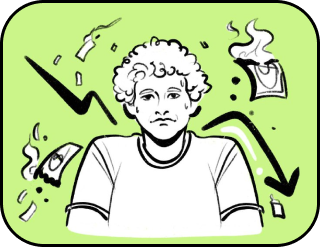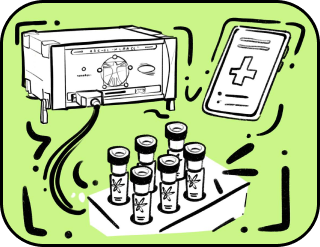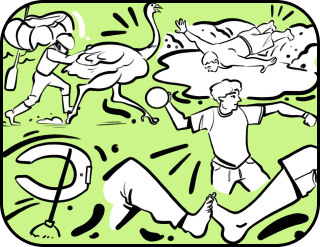How not to become obsessed with healthy living
Sometimes we hear the phrase, “I’m so tired of this fleeting life.” And right away, we get a series of comprehensive recommendations:
“Scientists have found out that if you eat only avocados, you can live forever. Or at least until you’re around 150.” The main thing is to make sure your body doesn’t start turning into a giant green fruit after 130. But even then, there’s a silver lining – you could delight your grandchildren by playing the role of the Great Avocado in their games.
“No food at all! Only cryogenic freezing! Freeze yourself now, and in 500 years, they’ll thaw you out, and you’ll be young and healthy again!” Though there’s no guarantee that humanity will still exist in 500 years, at least you might survive the apocalypse. Just don’t forget to leave instructions on how to thaw you out.
“Upload your consciousness to a computer. Transfer your mind to the cloud, and you can live forever!” You’d have to say goodbye to your physical body, but at least you could change your appearance whenever you like. Want to become a cat? Go ahead. Want to be an alien? No problem!
And recently, terpenes have entered the scene – substances found in essential oils of fruits, vegetables, spices, and especially conifers. A two-hour walk in a pine forest increases the number of immune cells in the body by 40%, and if you spend a couple of days in the forest, the number of immune cells will double, and the effect will last for a month.
Don’t forget about hygiene – after all, if you don’t wash your hands after kissing on a park bench, not only might the prince disappear, but more serious health concerns could arise.
And what about the brain? We need it to stay young and functional. “You can tickle your brain” by solving crosswords, puzzles, and doing memory exercises.
Modern scientific research opens up exciting possibilities for extending youth and health. How wonderful it is to easily handle daily tasks, radiating energy and enthusiasm, while keeping both body and mind in excellent shape – especially the latter. This isn’t just a dream; it’s an achievable reality, as long as you learn how to properly care for your body and outsmart time.
But there are more reasonable and plausible methods. However, not all these methods are equally beneficial, so it’s worth figuring them out to avoid getting lost in the whirlpool of pseudo-healthy lifestyles and harming your body. Both life experience and technological solutions can help with this.
It seems that the simple life advice like, “Forget about chips and soda; all you need are celery leaves and mountain spring water! Avoid stress! Laughter extends life!” has finally been heard.
Surprisingly, yesterday’s party lovers are now flocking to a healthy lifestyle: fresh juice instead of a glass of wine, the gym instead of a going to the club or bar. You might say there’s nothing wrong with that, but the health benefits of these eco-friendly hobbies are often questionable.
On Facebook, the hashtag #healthy_lifestyle has over 16.4 million posts, while #rave or #party barely scrape by with a modest 42,000 – healthy living is steadily overtaking what was once the primary entertainment for young people since the Beatles era. The ranks of party-goers who experienced the carefree ’90s and glamorous 2000s are thinning: no energy drink can get them back on the dance floor. “I’m paying off a Tesla loan, I have work on Monday, and my health isn’t what it used to be,” they shrug.
At the same time, health and work don’t prevent them from running ten kilometers a day or regularly hitting the gym for circuit training. It’s not that dancing requires some special physical resources; it’s just that dance marathons and a healthy lifestyle are in different camps – raving was always about fun, which never really aligned with the principles of healthy living that seem to have completely consumed modern minds.
In the U.S., for example, Daybreaker parties have been gaining popularity in recent years. These events start at five in the morning, and there’s no alcohol – instead of illegal substances, partygoers bring pedometers, and after this eco-friendly “rave,” they head straight to work or school. Even at a nightclub, you might easily run into an old friend holding a bottle of water instead of a glass of wine.
However, the widespread interest in a healthy lifestyle, oddly enough, is met with skepticism by doctors. Some people end up with torn menisci from a sudden obsession with treadmills, while others develop various eating disorders.
The term “orthorexia,” which refers to an obsessive focus on “healthy living and proper nutrition,” was coined by American doctor Steven Bratman in 1997. Although orthorexia is not yet officially recognized as a disease, more and more specialists are willing to acknowledge it as one – people stop eating normally, not for the sake of thinness, but in the name of health.
Super-bio-eco foods instead of regular products, smoothies instead of breakfast, carrot kvass instead of a pint of strong beer – these things start appearing in the life of a modern person who decides to take care of their health. Meanwhile, doctors keep reminding us that, from a biochemical perspective, fruits blended into smoothies are far worse for digestion than those that are chewed, and intense cardio workouts on polluted city streets are a questionable way to stay healthy. The concept of superfoods, in general, seems like clever marketing, which experts also point out: while one group of people is busy buying the latest unresearched longevity seeds, another group is declaring buckwheat the number one superfood.
“In all these trendy ideas about nutrition and longevity, the search for miracles often borders on ignorance. When a patient tells me they don’t eat tomatoes, for example, because they contain harmful lectins, the first thing I ask is what lectins are. So far, not a single patient has been able to give a clear answer,” says Francesco Marotta, a gastroenterologist at the renowned Henri Chenot wellness clinic. “Yes, tomatoes contain lectins, but they also have many essential vitamins and lycopene. The point isn’t to eliminate any specific food forever but to practice moderation – that’s what works in everything.”
The lack of moderation surprisingly connects an unhealthy lifestyle with a healthy one. Cardiologists remind us that heart attacks occur far more often in gyms than on dance floors – in other words, where people are trying to improve their health, not diminish it. One of the main pieces of advice for aspiring fitness enthusiasts is to ease into workouts gradually, rather than jumping into training everything at once, lifting the heaviest weights, and hitting the gym seven days a week. Similarly, few would argue that a nightly trip to the bar is beneficial, but it’s also unlikely that anyone would claim a couple of glasses of wine are a sure path to death.
However, not all healthy lifestyle enthusiasts are the same. Ethan is 22 years old, works as a promoter in a small advertising agency, dresses in branded clothing, knows all about trends, craft beer, parties, and writes electronic music. He’s also a biohacker.
“Last year, I read Dave Asprey’s book Head Strong, and some ideas really resonated with me: you can find a key to all the processes in your body and adapt them to yourself – tune your body through diet and supplements. I thought that with a few simple tricks, you could make sure that any party wouldn’t harm your health. I start preparing for an important party about a week in advance: I take magnesium and other electrolytes, omega-3, and tryptophan, from which the happiness hormone serotonin is formed. I make sure to add daily probiotics to my diet to strengthen my gut flora, and I eat more fermented vegetables. Two days before the party, I brew a strong bone broth, which I drink the day before and the day after the party. Before heading out, I take liver and pancreatic enzymes. And after the party, as soon as I wake up, I take a magnesium bath. I can easily party all weekend and feel fine on Monday. Plus, I regularly get blood tests and monitor my health.”
While experts refrain from commenting on the overall effectiveness and justification of such an approach, science has yet to provide clear evidence that Dave Asprey and his followers have truly hacked the system with mineral supplements and the unbeatable coffee blended with butter or coconut oil, which supposedly boosts brain performance to a new level. Of course, regularly getting tests done and monitoring micronutrient levels is likely more beneficial than not. However, it has not yet been definitively proven that bioactive supplements and diet can compensate for the damage caused by alcohol, drugs, or even tobacco, doctors say. “Stories about a grandfather who smoked like a chimney, drank like a fish, and lived to 98 are more about genetics – some people can live like that, while others eat perfectly, go to bed at 8 PM, and practice cold exposure their whole lives, only to die at the peak of their strength from a stroke. Even a genetic predisposition test won’t give you a clear answer about when and how you’ll die or what will help you live to 100 years old. At least, not yet.”
So, there’s no point in stressing over how perfect your lifestyle is; it’s better to more often follow the principle of moderation, which seems to be agreed upon by everyone: the joy of life is far more beneficial than the pursuit of ideals.
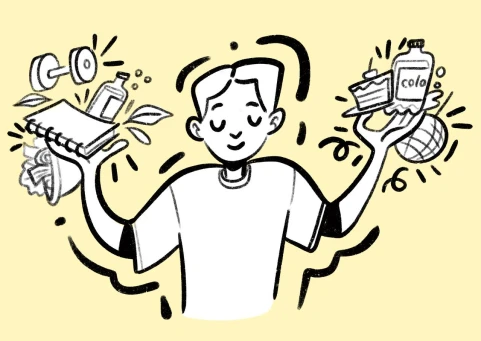
Once, an eccentric young man named Aaron Traywick climbed onto a chair at a biohacking conference, lowered his pants, and publicly injected himself with a gene therapy drug he had developed in his own lab to combat herpes. Scientists from government institutions called him crazy, while fellow biohackers called him a visionary. Whether the drug worked, no one will ever know: on April 30, 2018, Traywick’s body was found in a Washington D.C. spa. He was lying face down in a sensory deprivation tank filled with water.
The young life-extension activist didn’t live long enough to see the results of his latest tests, which might have shown whether the drug was effective. The circumstances of his death remain a mystery: Washington D.C. police stated they were considering the possibility of foul play. He was 28 years old.
Modern science offers a whole arsenal of tools to combat brain aging, such as biohacking – a new level of playing God. Imagine being able to take control of your body, and most importantly, your mind, and upgrade it like a powerful computer. Want to become more resilient? Easy! Want to improve your memory? No problem! Now, you control every process in your cells! So be it!
There are specific techniques to erase fatigue from the face of the earth. There are cocktails that will charge you up like a Tesla. There are pills to enhance cognitive functions. Biohacking is a whole new world of possibilities for those unafraid to experiment with their bodies. No, it doesn’t mean you’ll grow an extra pair of hands, fly on webs, or shoot lasers from your eyes. There won’t be any new functions. The goal is to maintain your body’s existing capabilities for as long as possible.
Biohacking is, first and foremost, about technology. It’s not about specific surgeries but a whole range of procedures and practices aimed primarily at rejuvenating and improving overall health. The system includes giving up bad habits – such as smoking, alcohol consumption, and unhealthy food – as well as establishing a strict routine for sleep, diet, activity, and rest.
“In theory, genetic engineering could allow you to grow a tail or feathers,” biohackers promise us. “People will be able to easily modify themselves, and genetic engineering will become another form of creative expression.”
Practical techniques are accompanied by daily detailed monitoring of the body’s condition so that any deviation from the norm can be promptly addressed to restore baseline levels, such as body temperature, blood pressure, heart rate, and so on.
A helmet, similar to the one worn by Professor Xavier in the Marvel Universe, is now available for purchase. While it can’t read minds yet, it can determine emotional states and assess concentration levels. These gadgets are also part of biohacking.
In the last century, neuroplasticity was discovered – the brain’s ability to generate new neurons and neural connections. It has been proven that mental abilities are not a gift but often a result of lifestyle. We create our own reality, and all the processes leading to the creation of this new reality begin in the mind. Neural connections can form at any age. The more we practice a particular action, the better we become at it, and the more neural connections we form. For example, to boost cognitive functions, it’s enough to expose yourself to unfamiliar or uninteresting information 1-2 times a week. A writer might learn the intricacies of accounting, or a technical genius might write a poem about an engine.
You don’t have to be exceptionally smart to earn a million. It’s enough to keep doing something, form new neural connections, and eventually, you’ll “hit the jackpot.”
Biohackers are obsessed with the brain. They’ve tried various methods to improve it, and one scientifically proven method is transcranial stimulation, which involves stimulation through the skull. There are two types of stimulation: magnetic and electrical. However, there is a downside. Scientists believe that trying to enhance the brain is a risky game: improving neuron activity in one area could harm the other one. For example, during brain stimulation for memorizing numbers, the process became significantly easier, but later, recalling the numbers without additional stimulation became more difficult.
To maintain the balance of the autonomic nervous system, reduce stress, improve brain function, boost mood, and overall have a positive impact on health, Feelzing patches were created.
Biohackers recommend using them when you need to stay active and focused, but your energy is running low. Seven minutes on the skin near the ear, a slight tingling sensation, and brain activity increases on average for about four hours.
We can’t forget about the magic of meditation either. Muse 2 is a device designed for meditation and relaxation practices: a headband equipped with sensors that track your breathing rate and depth, heart rate, brain activity, and physical movement during meditation. After each session, all the data is compiled in a mobile app and presented visually in charts and graphs, allowing you to monitor the quality of your thoughts. And then, if there are any thoughts you don’t like, you can simply hack them.
The Muse headband won’t turn you into a superhuman, but it will help relieve stress and anxiety by influencing your brain waves. The device also allows users to track on their smartphones or tablets whether they have managed to achieve a state of calm.
However, in late November 2017, the U.S. Department of Health issued a warning about the dangerous consequences of genetic engineering experiments. The alarm was raised after biohackers began publicly injecting themselves with untested substances to induce genetic changes.
Biohackers often test everything on themselves, which can make them seem like mad scientists, though they accompany their experiments with historical examples: throughout history, doctors have conducted experiments on themselves – such acts are considered ethically impeccable. For example, in the late 1920s, Russian physician Alexander Bogdanov performed blood transfusions on himself. He believed that transfusions would help him achieve eternal youth. He conducted ten successful transfusions, but the eleventh one killed him. Most likely, Bogdanov received a mismatched blood type, as the Rh factor wasn’t discovered until 1940.
In 1984, Australian doctor Barry Marshall, after unsuccessful tests on animals, drank a solution containing the bacterium Helicobacter pylori to prove its connection to gastritis and ulcers. The experiment worked: within days, he was experiencing nausea hourly. The story ended well: studying the bacterium became Marshall’s life’s work, and in 2005, he was awarded the Nobel Prize for it. Biohackers love to recall this story as well.
A major genetic experiment is currently being conducted by sixty-year-old microbiologist Brian Hanley. Three years ago, he developed a gene therapy that could delay aging. Hanley injected himself with the therapy and then underwent shock therapy, hoping that the electrical stimulation would help his cells better absorb the gene treatment. A year ago, he wrote on his blog: “Testosterone increased by 20%, and heart rate dropped by 10 beats per minute.” The genome development cost half a million dollars. In comments on his site, he expresses a willingness to have volunteers, but in his Facebook posts, he worries about fellow biohackers.
Josiah Zayner also aims to encourage his peers to experiment on animals rather than themselves, planning to offer DIY kits with live frogs.
Genetic enthusiasts are monitored by the FBI, which regularly gives lectures to local biohacker groups. In 2012, they organized a major conference and invited members of the DIYbio informal alliance to discuss internal community issues. Biohackers from around the world attended the conference. Most biohackers globally keep their distance from DIYbio and other “white hat” organizations. They hide in private Facebook groups, Reddit, and encrypted chats.
In the spring, a new hero emerged among biohackers. Justin Atkin, 22, appears to have made it his primary goal to conquer lactose intolerance through genetic engineering. Instead of injections and CRISPR, Atkin used a virus-vector pill to deliver a new gene to his DNA. He claims that his body now produces enzymes to break down lactose. Justin wishes for the medicine to have open-source code – software that anyone can run and improve.
On Reddit, there are over a thousand comments on a video showing Atkin working with the drug. People claiming to be scientists often write: “Dude, this is a great way to get cancer.” If the virus inserts the gene into the wrong DNA segment, Justin could end up with stomach cancer. Scientists have thus moved from viruses to the more precise CRISPR. But Atkin remains calm. He believes he understands the research better than Reddit commenters and sees no point in debating them: “The small risk of cancer is nothing compared to a lifetime of discomfort.” Justin smiles and talks about his new diet: for breakfast, he had a bagel with cream cheese, and for lunch – a sandwich with a thick slice of cheddar.
There’s nothing wrong with the desire to extend life by challenging nature. However, any unconventional medical method should be approached with caution. Perhaps, for today, we’ve covered enough technology.
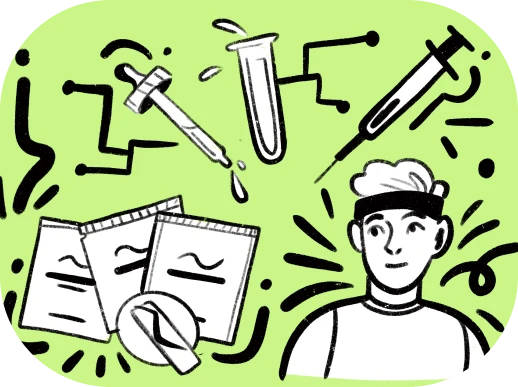
We scatter the fog of guesses with the beam of scientific truth.
Thank you!


